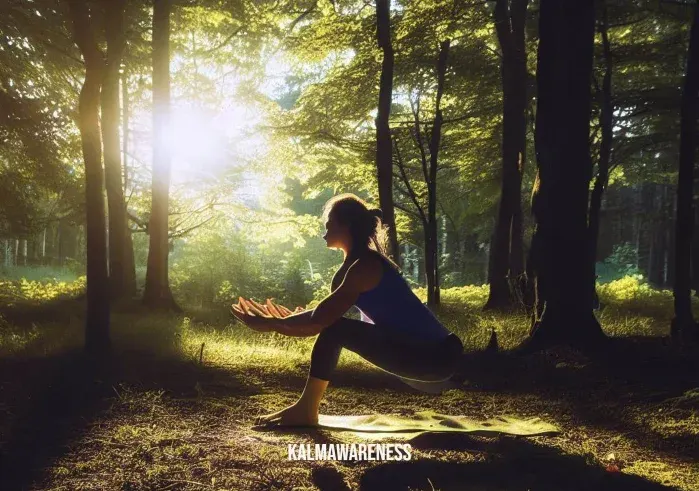Yoga Pose: The Goddess Squat
Goddess Squat Yoga Pose Original Name | Utkata Konasana Difficulty Level | Intermediate Pose Category | Standing Yoga Poses Exercise Duration | Beginners: Hold for 30 seconds to 1 minute. Advanced: Hold for 1 to 2 minutes.
The Goddess Squat, also known as Utkata Konasana, is a powerful and graceful yoga pose that strengthens the lower body while opening up the hips and promoting flexibility. This empowering pose is named after the Hindu goddesses, representing their strength and beauty. It is a must-try posture in your yoga practice, and in this article, we’ll guide you step by step on how to perform it with elegance and precision.
The Goddess Squat: A Powerful Asana
To start with, the Goddess Squat can be a bit challenging, especially for beginners, but with practice, it becomes an invigorating and rewarding posture. It engages various muscle groups, including the thighs, hips, core, and even the upper body, making it a fantastic full-body workout.
Step by Step Instructions:
- Begin in Mountain Pose: Stand tall with your feet slightly wider than hip-width apart and toes pointing forward. Keep your arms at your sides, palms facing outward, and your spine straight.
- Turn Your Toes Outward: Slowly turn your toes out to the sides, so your feet are at a comfortable angle. The wider you spread your feet, the deeper the squat will be.
- Bend Your Knees: Inhale deeply and start bending your knees, keeping them aligned with your toes. Lower your body down into a squatting position.
- Find Your Comfortable Depth: Bring your thighs parallel to the ground if possible, but it’s okay to have a smaller angle between your thighs and calves if you’re a beginner.
- Hands in Prayer Position: Press your palms together at your heart center, in a prayer position (Namaste), with your elbows gently pressing against your inner knees.
- Lengthen Your Spine: As you sink into the squat, elongate your spine and lift your chest upward. Keep your shoulders relaxed, away from your ears.
- Engage Your Core: Draw your belly button towards your spine to engage the core muscles. This helps stabilize your body and maintain balance.
- Stay Steady and Breathe: Hold the Goddess Squat for the recommended duration, breathing deeply and evenly. Keep your focus on the breath and feel the strength and grace of the goddesses within you.
“The Goddess Squat reminds us of the divine power that resides within. Embrace your strength and stand tall like a goddess.” – Unknown
Now that you’ve learned the initial steps of the Goddess Squat, let’s move on to the next part of the article, where we’ll explore variations and modifications for this empowering yoga pose. Are you ready to take your practice to a higher level? Continue reading to delve deeper into the art of Utkata Konasana. 🧘♀️

Goddess Squat Yoga Pose: Empower Your Body and Mind
Embracing the Benefits and Exploring Variations
In the first part of our journey, we delved into the essence of the Goddess Squat Yoga Pose (Utkata Konasana) and learned how to gracefully embody the strength of the divine goddesses. Now, let’s take our exploration to a deeper level as we uncover the wonderful benefits this pose has to offer, discover its variations for different levels of experience, and understand who should approach it with caution.
The Empowering Benefits of the Goddess Squat
The Goddess Squat is more than just a physical posture; it carries an array of mental, emotional, and spiritual advantages as well. As you gracefully sink into this pose, embrace the following benefits that will uplift both your body and soul:
- Strengthens the Lower Body: The primary focus of the Goddess Squat is on the lower body, especially the thighs, quadriceps, and glutes. Regular practice of this pose will result in toned and strengthened leg muscles.
- Hip Opener: Utkata Konasana opens up the hips and stretches the inner thighs, reducing tension and promoting flexibility in this often tight area.
- Improves Balance and Stability: Balancing in a deep squat requires concentration and stability, which in turn enhances your overall sense of balance.
- Empowers the Pelvic Area: This pose brings attention to the pelvic region, awakening the energy in the sacral chakra, and encouraging a sense of empowerment and creativity.
- Stimulates Digestion: The squatting position stimulates the digestive organs, aiding in digestion and helping to alleviate digestive issues.
- Elevates Mood: The combination of grounding and opening in Utkata Konasana can release emotional tension, leading to an uplifted and positive mood.
- Promotes Patience and Inner Strength: Holding the squat requires patience and inner strength. As you cultivate these qualities on the mat, they may also manifest in your daily life.
Who Should Avoid the Goddess Squat
While the Goddess Squat offers numerous benefits, it may not be suitable for everyone. If you have any of the following conditions or limitations, it is advisable to avoid this pose:
- Knee or Hip Injuries: Individuals with knee or hip injuries should approach this pose with caution or avoid it altogether, as it places considerable stress on these joints.
- Lower Back Issues: If you have chronic lower back pain or discomfort, it’s best to avoid deep squats like Utkata Konasana, as it could exacerbate the condition.
- Pregnancy: Pregnant individuals should avoid deep squats, especially during the second and third trimesters, to prevent any strain on the pelvic region.
Variations for Different Experience Levels
The beauty of yoga lies in its adaptability. The Goddess Squat can be modified and adjusted to suit practitioners of various experience levels. Here are some variations to explore based on your comfort and familiarity with the pose:
- Beginners: If you’re new to the Goddess Squat, you can use props like a block or a cushion under your sit bones to support your hips. This will make it easier to maintain balance and hold the pose comfortably.
- Intermediate Practitioners: As you gain confidence, try lifting your heels off the ground while in the squat position. This variation adds an extra challenge and intensifies the engagement of your leg muscles.
- Advanced Yogis: For those seeking a deeper experience, extend your arms overhead while in the Goddess Squat. This modification stretches the upper body, providing a more profound heart-opening sensation.
Embrace the Goddess Within You
The Goddess Squat Yoga Pose is a powerful and transformative posture that connects you to the divine strength within. As you practice this pose regularly, remember to approach it with reverence, gratitude, and self-compassion. Let the Goddess Squat be a reminder of your innate power and the vast potential that resides within you.

Goddess Squat Yoga Pose: Unveiling Its Ancient Roots and Spiritual Essence
The Rich History and Spiritual Significance
In the previous parts of our journey, we explored the empowering nature of the Goddess Squat Yoga Pose (Utkata Konasana), its benefits, variations, and considerations for practitioners. Now, let’s dive deeper into the historical origins of this pose, its spiritual significance, and valuable tips to enhance your experience. Additionally, we’ll learn about complementary poses that can further enrich your practice.
A Glimpse Into the Historical Roots
The practice of yoga dates back thousands of years and holds a vast history with numerous variations of poses. The Goddess Squat is deeply rooted in ancient yogic traditions, paying homage to the fierce, nurturing, and powerful qualities represented by various goddesses in Hindu mythology.
In Indian culture, goddesses symbolize feminine divinity, strength, and grace. Utkata Konasana, as a tribute to these divine beings, encourages practitioners to connect with their inner goddess and embrace the inherent strength and beauty within.
Embracing the Spiritual Significance
Beyond its physical benefits, the Goddess Squat holds profound spiritual significance. As you assume the pose, you can explore the following aspects to deepen your connection with the divine:
- Embodying Feminine Energy: The pose encourages practitioners, regardless of gender, to embrace and honor feminine energy. It is a reminder of the delicate balance between power and grace that exists within us all.
- Cultivating Fearlessness: The Goddess Squat, with its fierce and grounded stance, represents fearlessness in the face of challenges. By embodying this posture, you can tap into your inner courage and overcome obstacles.
- Connecting to the Earth Element: With your feet firmly rooted to the ground, the pose aligns you with the earth element. This connection fosters a sense of stability and grounding, allowing you to feel rooted in your spiritual journey.
Tips for a Fulfilling Goddess Squat Practice
To get the most out of your Goddess Squat experience, keep the following tips in mind:
- Maintain Steady Breathing: Deep, steady breaths will help you stay focused and relaxed while holding the pose.
- Engage Your Core: Activating your core muscles will provide stability and support to the entire body.
- Listen to Your Body: Honor your body’s limitations and make modifications if necessary to prevent discomfort or strain.
Common Mistakes to Avoid
Avoid these common errors to ensure a safe and effective Goddess Squat practice:
- Collapsing the Chest: Keep your chest lifted and open to maximize the heart-opening benefits of the pose.
- Knees Over Toes: Avoid letting your knees extend beyond your toes to protect your knee joints.
- Tensing the Shoulders: Relax your shoulders away from your ears to release tension in the upper body.
Modifications for Injuries and Limited Flexibility
If you have specific injuries or limited flexibility, consider these modifications:
- Chair Goddess Squat: Place a chair behind you and use it for support while performing the pose.
- Wall Support: Stand with your back against a wall to maintain balance and stability.
Complementary Poses for a Holistic Practice
To create a well-rounded yoga practice, include these complementary poses:
- Warrior Poses (Virabhadrasana I, II, III): These poses strengthen the legs and increase stamina, aligning well with the grounding nature of the Goddess Squat.
- Cobra Pose (Bhujangasana): Counterbalance the squatting position with this gentle backbend to open the heart and stretch the spine.
- Pigeon Pose (Eka Pada Rajakapotasana): Deepen the hip-opening aspect of Utkata Konasana with this intense stretch.
Embrace the Goddess Within
As we conclude this yoga journey, remember that the Goddess Squat Yoga Pose is not just a physical posture; it is a profound embodiment of strength, grace, and divine energy. As you continue your practice, honor the goddess within you and let her shine brightly in every aspect of your life.
May the Goddess Squat inspire you to embrace your power, walk with confidence, and radiate love and compassion to all beings around you.
Namaste




